Brian Schiff’s Blog
Injury Prevention, Sports Rehab & Performance Training Expert
It has been a while since my last post. To be honest, I have been busy with preparing/presenting my live seminar last week and webinars, as well as fulfilling my writing obligations and clinical role. So, I have been taking a “break” from blogging and recharging the battery so to speak.
Now I am getting back to it. The great thing about presenting though is that I am consistently reading and reviewing the latest research on topics related to my presentations and closely examine my rehab and exercise philosophy. In my clinic, I treat many runners for knee pain.
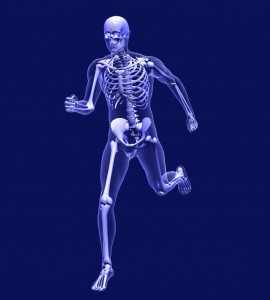
The average profile is an experienced runner b/w the ages of 25 and 50 who logs 20 – 35 miles per week and routinely competes in half marathons or some sort of triathlons.
Common injuries include IT band problems versus lateral meniscus tears versus patellofemoral pain. Often, I uncover the following things related to kinetic chain deficiencies:
- Elevated or rotated inominate
- Ankle dorsiflexion restriction (OH squat assessment)
- Poor single leg stance
- Weak lateral myofascial chain
- TFL dominance
- Excessive femoral internal rotation/adduction with single leg squats
- Tightness in hip flexors, ITB and soleus
Many currently debate the efficacy of foam rolling. Is it worthwhile? Some say yes, while others say no.
While I treat a vast number of knee ailments in my practice, the focus of my training and rehab is often more proximally directed at the hip. Understanding the role of hip muscles and how the hips and pelvis work together to impact knee alignment and closed chain function is critical in resolving knee pain and dysfunction.
Below is a “go to exercise” exercise I use for gluteus medius activation and core/pelvic stability training. Using a mini-band provides an adduction force cueing the client to abduct and activate their external rotators to maintain proper alignment. Additionally, they need to avoid a drop on one side of the pelvis (look at the ASIS).
Click here to read my entire column dedicated to this exercise in PFP’s online magazine. I hope you find this exercise and information useful for you and/or your clients.
I have been a bit behind on blogging as of late. I try to aim for one per week, but I also strive to deliver sound and relevant content. Additionally, I do not seek outside contributors so finding time to write can be tricky with work and family life too. So, forgive me for any apparent inconsistency in posting. Just know that I will always try to provide valuable content. Today’s post centers around an article in the July 2012 edition of AJSM.

My work at the Athletic Performance Center has provided me an increased opportunity to work with FAI and athletic hip injuries. This is an area of evolution and growth in our field, so I find it particularly interesting to see rationale and thought processes centering around the timing, contribution and selection of hip exercises for active patients/athletes.
This article comes from the Steadman Philippon Research Institute in Vail, CO. The purpose of the study was to measure the highest activation of the piriformis and pectineus muscle during various exercises. The hypothesis was that highest pectineus activation would occur with hip flexion and moderate activity with internal rotation, whereas the highest activation with the piriformis would be with external rotation and/or abduction.
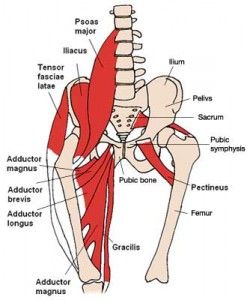
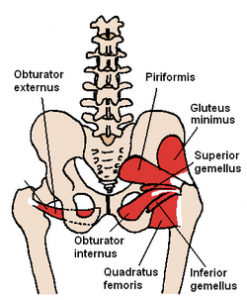
Methods: 10 healthy volunteers completed the following 13 exercises:
- Standing stool hip rotation
- Supine double leg bridge
- Supine single leg bridge
- Supine hip flexion
- Side-lying hip ABD with external rotation
- Side-lying hip ABD with internal rotation
- Side-lying hip ABD against a wall
- Hip clam exercise with hips in 45 degrees of flexion
- Hip clam exercise with hips in neutral
- Prone heel squeeze
- Prone resisted terminal knee extension
- Prone resisted knee flexion
- Prone resisted hip extension
All of these exercises have been reported to be used in hip rehab following arthroscopy or recovery from injury. The exercises were executed slowly and methodically with a metronome to reduce EMG amplitude variations.
Over the past several years, the trend in the health and fitness industry has been toward injury prevention and movement screening. Gray Cook and Lee Burton have given us the FMS. More recently, the Y-Balance test has emerged as another tool to assess asymmetry in the upper and lower quarter.
I am currently FMS certified and planning to attend the SFMA course next month in Durham. I routinely incorporate the FMS in both our rehab and sports performance work at the APC. I like many things about the screening exam. It provides a consistent tool to assess baseline movement and record asymmetry on a simple 4 point scale scale. It also has been shown to have good intra and inter-rater reliability. Click here for a recent study published in the Journal or Orthopaedic & Sports Physical Therapy.
For those unfamiliar with the screen, it is 7 tests scored on a 0-3 scale as follows:
- 0 = pain
- 1 = unable to perform the movement pattern (or perform with marked dysfunction)
- 2 = performs the movement with a mild compensation
- 3 = performs the movement correctly
I would say on average, most of the athletes I screen score between a 12 and 15. My highest score was a 19 (9 year old gymnast) and my lowest was a 9 (NFL lineman). As screeners, we are charged with uncovering asymmetry and faulty movement patterns. What do you see in the following picture?
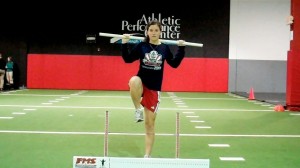
Clearly, the dowel is not level, thus we score it a 2. She also had some ER in the right leg when stepping over the hurdle. She was a symmetrical 2 on the hurdle step test. This is a Division I soccer player who scored 17 on the exam.
Most of the movements seem straightforward. However, many question what the rotary stability test measures with respect to the ideal 3 score (ipsilateral movement)? It assesses an unnatural movement pattern to be sure. This athlete failed miserably on the ipsilateral pattern but scored a solid 2 with the contralateral pattern.
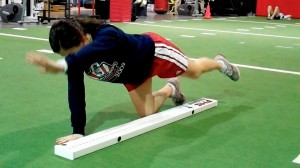
I have yet to test someone who can score a legitimate 3. I have seen some get a 3 on one side and 2 on the other (asymmetrical and a red flag in FMS land). As one who naturally questions things, I find myself questioning how many are truly capable of scoring a 3.
So, a very common issue I see in runners is iliotibial band (ITB) syndrome. In a nutshell, it involves excessive rubbing or friction of the ITB along the greater trochanter or lateral femoral epicondyle. It is more common along the lower leg just above the knee and typically worsens with increasing mileage or stairs.
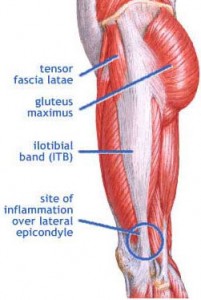
The ITB is essential for stabilizing the knee during running. Several factors may contribute to increased risk for this problem:
- Muscle imbalances (weak gluteus medius and deep hip external rotators)
- Uneven leg length
- High and low arches
- Increased pronation leading to excessive tibial rotation = friction of the band
- Improper training progression
- Faulty footwear
- Poor running mechanics
- Limited ankle mobility (specifically dorsiflexion)
- Tightness in the tensor fascia latae (TFL) and glute max
Related information on this topic include a 2010 study published in JOSPT on competitive female runners with ITB syndrome:
Click here to see the abstract of the study
Click here to read an earlier blog post analysis of the above research article
Common signs and symptoms include stinging or nagging lateral knee pain that worsens with continued running. Hills and stairs may further aggravate symptoms. Some runners even note a “locking up” sensation that forces them to stop running altogether. How do I treat this?

